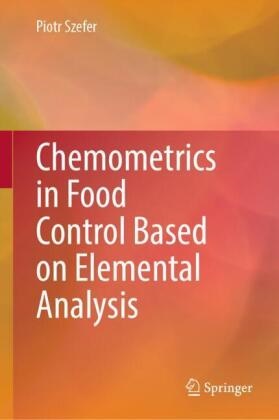Condividi
Fr. 206.00
Piotr Szefer
Chemometrics in Food Control Based on Elemental Analysis
Inglese · Copertina rigida
Pubblicazione il 17.09.2025
Descrizione
This book presents an overview of chemometric assessments of analytical dataset in order to determine the authenticity/adulteration of food, animal and plant origin, including meat, fish, seafood, milk and dairy products, honey, cereals and grains, olive oils and oilseeds, vegetables, mushrooms, fruits, tea, coffee, cocoa, sugar, mineral and drinking water, and wines and other alcoholic beverages. The text uses modern analytical methods/techniques coupled with appropriate chemometric tools to demonstrate that chemometrics is a necessary and powerful tool for food analysis and its control. Another main concern is traceability, i.e. the possibility of verifying the geographical, animal/botanical and/or productive origin of a foodstuff; hence the use of chemometric techniques is not only recommended but essential. Since the food is characterized by a complex matrix, the strategy to study its elemental profile should be multivariate. The reported data are extensively tabulated and graphically presented. This book is useful for food chemists, quality control professionals, nutrition and public health educators, analytical chemists, food manufacturers, environmental scientists and students, and practicing professions in food chemistry and food safety.
Sommario
CHAPTER 1. Key Issues Constituting the Book Content.- CHAPTER 2. Meat and its Products.- CHAPTER 3. Fish Flesh.- CHAPTER 4.Seafood (Molluscs and Crustaceans).- CHAPTER 5. Milk and Dairy Products.- CHAPTER 6. Honey and its Products.- CHAPTER 7. Cereal and its Products.- CHAPTER 8. Olive Oils and Oilseeds.- CHAPTER 9. Vegetables, Legume Seeds and Spices.- CHAPTER 10. Mushrooms.- CHAPTER 11. Fruits and their Products.- CHAPTER 12. Tea and its Infusion.- CHAPTER 13. Coffee and its Infusion.- CHAPTER 14. Cocoa, Sugar and their Products.- CHAPTER 15. Mineral and Drinking Water.- CHAPTER 16. Wine and other Alcoholic Beverages.
Info autore
Piotr Szefer was employed during 1972-2000 in the Department of Analytical Chemistry, Medical University of Gdańsk (MUG). He received his MSc (1972), PhD (1978), and DSc (1990). He was awarded Full Professorship in January 2000. His research is focused on analytical chemistry, environmental analytics, trace analysis, food and marine chemistry and bioanalytics. During 1996-2002, he was Dean of the Faculty of Pharmacy, MUG. He was the head of the Department of Food Sciences, MUG. He has published 5 books with Elsevier Science B.V., CRC Press – Taylor & Francis, Marine Board, European Science Foundation, and Maralte BV.
Piotr Szefer was also the Guest Editor of two special issues of journals such as Applied Geochemistry (Pergamon – Elsevier Science Ltd., 1998) and Marine Pollution Bulletin (Pergamon-Elsevier, 2004). He has published ca. 50 book chapters including 20 international ones (published by e.g. Springer, Elsevier, Taylor & Francis and Nova Science Publishers, Inc.), 370 papers and more than 300 symposia abstracts. He has been a member of more than 30 international and national research consortiums, expert panels, working groups as well as scientific associations and organizations (e.g. WG MB-ESF, SCOR, WGMS-ICES) as well as a member of 20 editorial boards of international journals (published by e.g. Elsevier, Springer-Versita, Taylor & Francis, Bentham). He has reviewed more than 2000 manuscripts for ca. 120 different journals, mainly with an international reputation. He published with ca.100 Polish scientists and ca. 150 scientists originated from ca. 50 countries. He has visited 16 countries as visiting professor or research scientist. He received (as host scientist) in his Department different researchers from 17 countries.
Piotr Szefer has been lately ranked among the top 2% of researchers in the world.
Riassunto
This book presents an overview of chemometric assessments of analytical dataset in order to determine the authenticity/adulteration of food, animal and plant origin, including meat, fish, seafood, milk and dairy products, honey, cereals and grains, olive oils and oilseeds, vegetables, mushrooms, fruits, tea, coffee, cocoa, sugar, mineral and drinking water, and wines and other alcoholic beverages. The text uses modern analytical methods/techniques coupled with appropriate chemometric tools to demonstrate that chemometrics is a necessary and powerful tool for food analysis and its control. Another main concern is traceability, i.e. the possibility of verifying the geographical, animal/botanical and/or productive origin of a foodstuff; hence the use of chemometric techniques is not only recommended but essential. Since the food is characterized by a complex matrix, the strategy to study its elemental profile should be multivariate. The reported data are extensively tabulated and graphically presented. This book is useful for food chemists, quality control professionals, nutrition and public health educators, analytical chemists, food manufacturers, environmental scientists and students, and practicing professions in food chemistry and food safety.
Dettagli sul prodotto
| Autori | Piotr Szefer |
| Editore | Springer, Berlin |
| Lingue | Inglese |
| Formato | Copertina rigida |
| Pubblicazione | 17.09.2025, ritardato |
| EAN | 9783031996863 |
| ISBN | 978-3-0-3199686-3 |
| Pagine | 599 |
| Illustrazioni | XXXVII, 599 p. 202 illus., 61 illus. in color. |
| Categorie |
Scienze naturali, medicina, informatica, tecnica
> Chimica
> Chimica teorica
Analytische Chemie, Food chemistry, Bioanalytical Chemistry, Chemometrics, Food Analysis, Elemental Analysis, food quality assessment, food authenticity recognition, multielemental stable isotope dataset |
Recensioni dei clienti
Per questo articolo non c'è ancora nessuna recensione. Scrivi la prima recensione e aiuta gli altri utenti a scegliere.
Scrivi una recensione
Top o flop? Scrivi la tua recensione.

